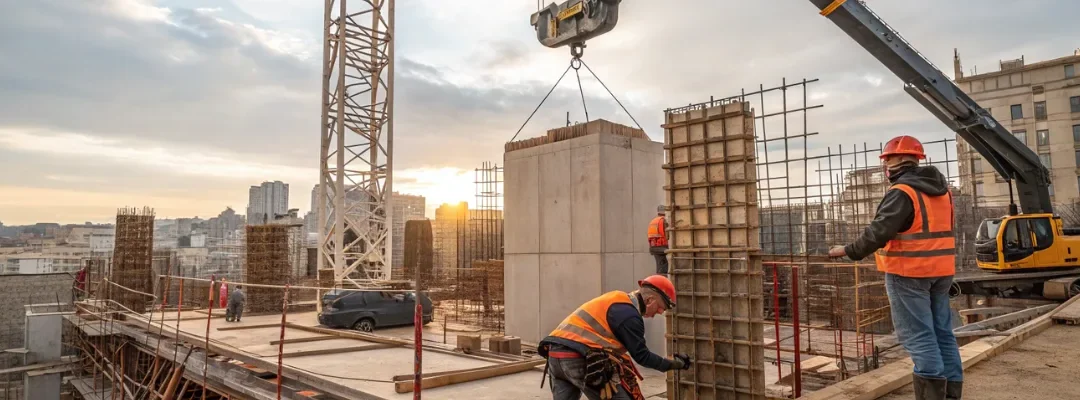The Future of Construction Is Here
The construction industry has evolved far beyond bricks and mortar. Today, advanced construction techniques are revolutionizing how we design, build, and maintain buildings and infrastructure. These modern methods help address challenges like labor shortages, rising costs, sustainability goals, and the demand for faster delivery.
In this guide, you’ll discover the most impactful advanced construction technologies and techniques, their benefits, real-world applications, and how they’re shaping the future of construction.
What Are Advanced Construction Techniques?
Advanced construction techniques are modern methods and technologies that improve speed, efficiency, safety, and sustainability in building projects. They include innovations in materials, design processes, machinery, and construction methods.
Top Advanced Construction Techniques in 2025
1. Precast and Prefabrication
- What it is: Building components are manufactured off-site and assembled on-site.
- Benefits: Faster build time, better quality control, reduced waste
- Used for: Modular homes, bridges, commercial complexes
2. 3D Printing in Construction
- What it is: Layer-by-layer construction using concrete or other materials
- Benefits: Cuts construction time by up to 60%, reduces material waste
- Used for: Low-cost housing, remote builds, customized design features
3. Robotics and Automation
- What it is: Robots for bricklaying, concrete pouring, and site inspection
- Benefits: Precision, safety, labor efficiency
- Used for: Large-scale construction, repetitive tasks, hazardous areas
4. Building Information Modeling (BIM)
- What it is: A digital model integrating design, construction, and operations
- Benefits: Clash detection, cost and time savings, lifecycle tracking
- Used for: Commercial buildings, infrastructure, smart cities
5. Cloud-Based Construction Management
- What it is: Project tracking, documentation, and communication via cloud software
- Benefits: Real-time updates, team coordination, fewer delays
- Used for: All project types, especially remote and multi-location builds
6. Sustainable Construction Methods
- Examples: Green roofs, passive solar design, recycled materials
- Benefits: Energy efficiency, lower emissions, compliance with green standards
- Used for: LEED-certified buildings, eco-friendly developments
7. Drones in Construction
- What it is: Aerial site surveys, progress tracking, inspection
- Benefits: Saves surveying time, improves safety and documentation
- Used for: Large sites, real estate, infrastructure projects
8. High-Performance Materials
- Examples: Self-healing concrete, aerogel insulation, ultra-high-performance concrete (UHPC)
- Benefits: Increased durability, thermal efficiency, reduced maintenance
- Used for: Bridges, skyscrapers, energy-efficient buildings
9. Modular Construction
- What it is: Entire sections (modules) of a building are constructed in factories
- Benefits: Reduced construction time, consistent quality, less on-site labor
- Used for: Schools, hotels, apartments, hospitals
10. Augmented Reality (AR) and Virtual Reality (VR)
- What it is: Immersive visualization tools for design, walkthroughs, and training
- Benefits: Reduces errors, enhances client understanding, improves planning
- Used for: Design validation, safety training, stakeholder presentations
Real-World Examples
| Technique | Project |
|---|---|
| Modular Construction | Marriott Hotel, New York (built in 90 days) |
| 3D Printing | ICON Homes, Austin TX |
| BIM + Drones | Delhi Metro Phase IV |
| Precast Concrete | Metro Rail Infrastructure in Chennai & Pune |
Benefits of Advanced Construction Techniques
| Advantage | Impact |
|---|---|
| Faster Completion | Cuts project timelines by 30–60% |
| Cost Efficiency | Reduces rework and material wastage |
| Enhanced Quality Control | Off-site fabrication ensures consistency |
| Improved Safety | Reduces site risks through automation |
| Sustainability | Optimized design and green materials |
Challenges & Considerations
- High Initial Investment in machinery and training
- Skilled Labor Shortage for tech-based tools
- Regulatory Barriers in traditional construction zones
- Adoption Resistance from legacy firms
FAQs
Q: Are advanced construction techniques only for large projects?
A: No. Many modern methods like prefab and BIM are scalable for small residential and commercial projects too.
Q: Will these technologies replace workers?
A: Not replace, but enhance. They reduce repetitive tasks and free up skilled workers for critical decision-making.
Q: Is advanced construction more expensive?
A: Initial costs may be higher, but long-term savings and efficiency gains typically result in a higher ROI.

